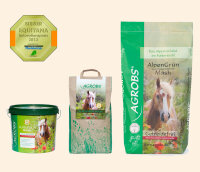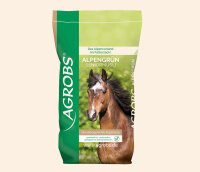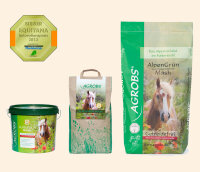Compound feed for horses
According to literature a horse is considered "old" from the age of about 18 - 20 years. However, there is no uniform definition for this.
The fact that horses get old is by showing grey hair in the head area, changes in metabolism, reduced regenerative ability and by complete abrasion or loss of teeth. Now the needs of the ageing horse, which generally makes less use of its feed, must be addressed. The aim of feeding old horses should be an adequate intake of energy and nutrients to maintain good body condition.
In most cases, the biggest problem here is the loss of teeth or the loss of individual teeth. It is becoming more and more difficult for horses to chew basic feed and to ingest sufficient amounts of it. Signs of this are the formation of "hay rolls". Due to the insufficient supply of crude fibre, horses lose body weight, the intestinal flora is disturbed, diarrhoea or colic are often the result.
Forrage is and remains the basis of horse nutrition, even in old age. If there are problems with the intake of basic feed, sensible alternatives must therefore be found. Counteracting these problems by increasing the amount of concentrated feed usually only brings short-term success; in the long term, the nutritional status deteriorates.
PRE ALPIN SENIOR are dry green fibres, especially for old horses or for horses that cannot chew enough basic feed. The fibre length of approx. 3 - 20 mm corresponds to the ground basic feed if the horse's dentition is intact. PRE ALPIN SENIOR thus completely covers the horse's raw fibre requirements. It is also dust and mildew free.
The addition of cold-pressed linseed oil offers further advantages. Besides energy, it supplies the horse with essential fatty acids.
INGREDIENTS : Meadow grasses and herbs, oil mixture cold-pressed (linseed oil, camelina oil)
AREAS OF USE
- as basic feed (100 % hay substitute)
- for enhancement of hay, silage, pasture
- as substitute for concentrated feed
- in case of undersupply with applicable crude fibre, e.g. due to tooth loss
- in case of age-related weight loss
- for increasing fluid in take
- extends feeding time
- in case of chewing and dental problems
- for masking medication
FEEDING RECOMMENDATION
- as basic feed (100 % hay substitute): approximately 1.5 kg per 100 kg ideal body weight per day
- as concentrated feed: 1.2 kg substitute approximately 1 kg of grain
- for enhancement of the basic feed: 1 kg substitutes approximately 1 kg of hay introduce new feed gradually
AGROBS® recommends to dampen feed in generally for old horses, horses with teeth problems or low water intake.
ANALYTIC COMPONENTS
| crude proteins |
8,10 % |
lysine |
0,33 % |
| crude oil and fats |
2,70 % |
methionine |
0,13 % |
| crude fibre |
26,90 % |
cystine |
0,09 % |
| crude ash |
6,90 % |
threonine |
0,33 % |
| |
|
|
|
| calcium |
0,49 % |
starch |
1,54 % |
| phosphorus |
0,24 % |
sugar* |
9,75 % |
| magnesium |
0,20 % |
fructan |
5,84 % |
| chloride |
0,39 % |
|
|
| sodium |
0,02 % |
digestible energy |
7,87 DE MJ/kg |
| potassium |
1,50 % |
metabolisable energy |
6,60 ME MJ/ kg |
| sulphur |
0,14 % |
precaec. dig. crude protein |
4,55 % |
| |
|
|
|
| zinc |
23,00 mg/kg |
|
|
| manganese |
81,00 mg/kg |
|
|
| copper |
4,80 mg/kg |
|
|
| selenium |
0,17 mg/kg |
|
|
The analysed values are of native origin. * The analysed sugar value is included in a purely native way. No artificial sugar has been added.
Status 01/2022

 German
German French
French




